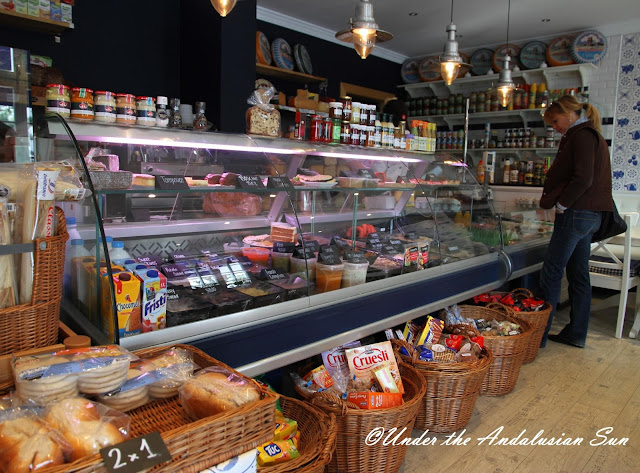I'm not particularly innovative or creative cook. The wheel won't be invented in this kitchen (we'd rather call for a cab). So there's a chance this just might be the only original idea I'll ever have. But it is pretty darn genius.
Let's call it Salvador Dali's spaghetti as an homage to Spain's own son, who, at times, truly was genius. When he wasn't being just plain crazy. The name is also fitting because with his work, what you see is often not real. Same applies here. It looks like meatball spaghetti but that it ain't.
The dish was created by an accident when I lived in Tunis. Back then my Saturday morning ritual was to head to the Central Market, where I bought the fresh fish, seafood, veggies and merguez sausages for the week ahead. After returning home, I'd pour myself a glass of rosé and start cooking lunch. The seafood selection at the market was superb and inevitably my eyes got greedier than my stomach (or fridge) could accommodate. I used to eat squid there a lot, too, and once, as I was cutting squid into rings I had, deep in my own thoughts, just continued cutting the squid- resulting in one continuous squid strip. I proceeded to cut it even thinner and voilá- carb-free spaghetti was born.
In Tunis I used to have this stir-fried along with the rest of the seafood goodies from the market or drenched with sauce made from lamb merguez, onion, green pepper and a dollop of cream (more on this recipe later). This time I made some prawn balls to go with it and yikes and wowcha, it was goooood.
Let's call it Salvador Dali's spaghetti as an homage to Spain's own son, who, at times, truly was genius. When he wasn't being just plain crazy. The name is also fitting because with his work, what you see is often not real. Same applies here. It looks like meatball spaghetti but that it ain't.
The dish was created by an accident when I lived in Tunis. Back then my Saturday morning ritual was to head to the Central Market, where I bought the fresh fish, seafood, veggies and merguez sausages for the week ahead. After returning home, I'd pour myself a glass of rosé and start cooking lunch. The seafood selection at the market was superb and inevitably my eyes got greedier than my stomach (or fridge) could accommodate. I used to eat squid there a lot, too, and once, as I was cutting squid into rings I had, deep in my own thoughts, just continued cutting the squid- resulting in one continuous squid strip. I proceeded to cut it even thinner and voilá- carb-free spaghetti was born.
In Tunis I used to have this stir-fried along with the rest of the seafood goodies from the market or drenched with sauce made from lamb merguez, onion, green pepper and a dollop of cream (more on this recipe later). This time I made some prawn balls to go with it and yikes and wowcha, it was goooood.
The squid I used was 20 cm x 8 cm, cut into thin ribbons. The smaller ones make for thinner (and perhaps a bit more tender?) ribbons, but you'll need more of those. One 20 cm 8 cm squid made enough spaghetti (appr. 1,5 dl) for one portion. If you can't get your hands on whole squid, you could, of course, use the frozen ready-cut rings (the plain, not the breaded kind). In that case you might want to cut them into thinner width.
When cooking squid one must always remember that it should (depending on the size, too) be cooked either really quickly or really long. For this dish you can either cook it in salted boiling water for about one minute or flash fry it on the pan in a little bit of oil.
The prawn balls I made from those supersized king prawns I've been raving about, but you can use the smaller sized too - as long as the quantity is the same. For this recipe the quantity was appr. 2,5 dl of chopped prawns. That yields (depending on the size of your balls....) 9-10 prawn balls.
For 2
10 really big king prawns
1/2 (heaped) tsp grated lemon zest
1 heaped tbsp chopped spring onions (or chives)
1 heaped tbsp chopped parsley
1/2 chilli, chopped finely
(tune it down or up depending on the fieriness of your chillis)
1 heaped tbsp bread crumbs
1,5 tbsp tomato sauce
1,5 tbsp water
salt, pepper to taste
1 heaped tbsp chopped parsley
1/2 chilli, chopped finely
(tune it down or up depending on the fieriness of your chillis)
1 heaped tbsp bread crumbs
1,5 tbsp tomato sauce
1,5 tbsp water
salt, pepper to taste
Mix the tomato paste and water and mix with the bread crumbs. Let the crumbs absorb the liquid. Then add the chopped prawns (I chopped them with a knife, all Kamikaze sushi chef-style, but I'm sure you can use a machine) and the rest of the ingredients. Let them rest in the fridge while you make the sauce.
1/2 small onion, shopped finely
1 tsp pimiento or any other mild paprika 1 tsp grated orange zest
1/2 tsp ginger
1/2 chilli (again, adjust according to the fieriness of the chilli you're using)
1/2 tsp tomato concentrate
2 dl tomato sauce
2 dl shell fish stock
a dash of white wine (or sherry or lemon juice)
salt, pepper to taste
handful of chopped parsley
1/2 tsp ginger
1/2 chilli (again, adjust according to the fieriness of the chilli you're using)
1/2 tsp tomato concentrate
2 dl tomato sauce
2 dl shell fish stock
a dash of white wine (or sherry or lemon juice)
salt, pepper to taste
handful of chopped parsley
Heat some oil in a pan. Add the onion, orange zest, ginger, garlic, chilli and paprika powder. Cook, while stirring, until the onions have softened and are transluscent. Add the white wine and bring to boil. The pour in the shellfish stock and tomato sauce. Let bubble on moderate heat and check the taste. Season with salt and pepper. Now roll the prawn balls.
Roll the paste into little balls of equal size (lightly oiled hands help, though the mixture is sticky. It easier to form when it's been cooled though) and gently drop them into the sauce. Treat with care, as the texture is more vulnerable than that of the meatballs.
Cook in moderately low heat until done, about 5 minutes.
Cook the squid spaghetti, either in a pan or in rapidly boiling water. Place in a bowl and top with sauce. Scatter the parsley on top and fire away.
Roll the paste into little balls of equal size (lightly oiled hands help, though the mixture is sticky. It easier to form when it's been cooled though) and gently drop them into the sauce. Treat with care, as the texture is more vulnerable than that of the meatballs.
Cook in moderately low heat until done, about 5 minutes.
Cook the squid spaghetti, either in a pan or in rapidly boiling water. Place in a bowl and top with sauce. Scatter the parsley on top and fire away.
And if squid doesn't float your boat, the sauce and the balls are good with regular spaghetti too...






















































